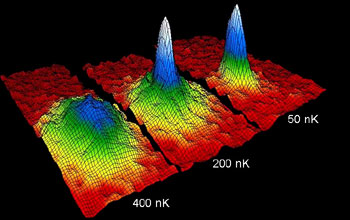Multimedia Gallery
Finding the Bose-Einstein Condensate
A series of three false-color images of a gas of ultra-cold rubidium atoms at temperatures of (left to right) 400, 200 and 50 nanoKelvins (nK) show the emergence of a Bose-Einstein condensate (BEC). At 400 nK, the atoms behave like a conventional gas, with a smooth distribution of high- and low-energy atoms. At 200 nK, the BEC begins to appear in the form of a significant fraction of near-zero energy atoms, shown as a peak in the center of the image. The skirt surrounding the peak is the remaining noncondensed atoms. By 50 nK, the noncondensed fraction has all but vanished, leaving about 3,000 atoms in a single, macroscopically occupied wavefunction known as the BEC. The images are about 200 micrometers on a side.
More About this Image:
The first demonstration of the BEC in a gas was made in 1995 by Eric Cornell, an adjoint professor at the University of Colorado, physicist at the National Institute of Standards and Technology and National Science Foundation-supported researcher, and his colleague Carl Wieman.
As predicted by Albert Einstein 70 years ago, atoms, when cooled to temperatures approaching absolute zero, condense into a "superatom," behaving as a single or collective entity. Quantum theory also predicts that matter behaves like a wave. This wave-like behavior is evident when matter is cooled enough for its atoms to coalesce into this collective quantum state.
Cornell was awarded the Alan T. Waterman Award by the National Science Board in May 1997 for his work in this area, the highest honor for young researchers. He was also named a Nobel Laureate in physics in 2001. Cornell's experiments since then have established the area as an exciting new field of physics. Many physicists consider the creation of the BEC the most important discovery since high-temperature superconductivity. It's a new macroscopic state with unique and fascinating properties. Its applications have included the transformation of the field of atom interferometry in much the same way the laser revolutionized optical interferometry. Cornell's work has opened up a rich and fascinating physical system with a host of further questions to explore. (Year of image: 1995)
SORRY: THIS IMAGE IS NOT AVAILABLE IN HIGH-RESOLUTION FORMAT
Credit: Mike Matthews, JILA
Images and other media in the National Science Foundation Multimedia Gallery are available for use in print and electronic material by NSF employees, members of the media, university staff, teachers and the general public. All media in the gallery are intended for personal, educational and nonprofit/non-commercial use only.
Images credited to the National Science Foundation, a federal agency, are in the public domain. The images were created by employees of the United States Government as part of their official duties or prepared by contractors as "works for hire" for NSF. You may freely use NSF-credited images and, at your discretion, credit NSF with a "Courtesy: National Science Foundation" notation.
Additional information about general usage can be found in Conditions.
Also Available:
Download the high-resolution JPG version of the image. (245 KB)
Use your mouse to right-click (Mac users may need to Ctrl-click) the link above and choose the option that will save the file or target to your computer.



